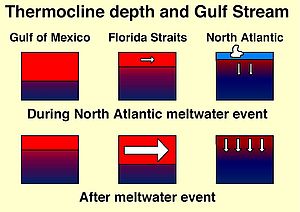Living conditions in central Europe largely depend on heat supply from the Gulf Stream. The strength and northward extent of this current depends on the formation of North Atlantic Deep Water (NADW) in the Norwegian-Greenland and Labrador seas (Thermohaline Circulation). The deep-water formation was highly variable during the geological past. Large volumes of fresh water were shed into the northern North Atlantic during transient glacier retreat and continental ice sheet desintegration phases during the last ice age (Glacial Terminations, Heinrich Events). The melt waters decreased the sea surface salinity, density, and diminished deep convection. A compensating import of tropical warm water was reduced resulting in a decreased northward oceanic heat flux and a colder North Atlantic climate. As less heat is transported to the North Atlantic, the Caribbean as source region of the Gulf Stream, the South Atlantic and even parts of the Southern Hemisphere warm up (Bipolar Seesaw). Once the formation of North Atlantic Deep Water resumed again, a strong pulse of warm and salt-rich water from the south boosted the deep convective overturning and effected a warmer climat e in the North Atlantic region. Similar but more subtile changes of the North Atlantic Circulation were also felt during historical times (Little Ice Age, Medival Warm Period). It is therefore essential to better understand the role of the tropical ocean as salt and heat provider for the Thermohaline Circulation, atmospheric feed-back mechanisms and interhemispheric teleconnections, and the long-term impact of changes in solar irradation due to changes in earth's orbital parameters.
Florida Straits throughflow and its relationship to high northern latitude climate
Heinrich Events
Bipolar Seesaw
Dynamics of Antarctic Intermediate Water
Ocean tunnel



